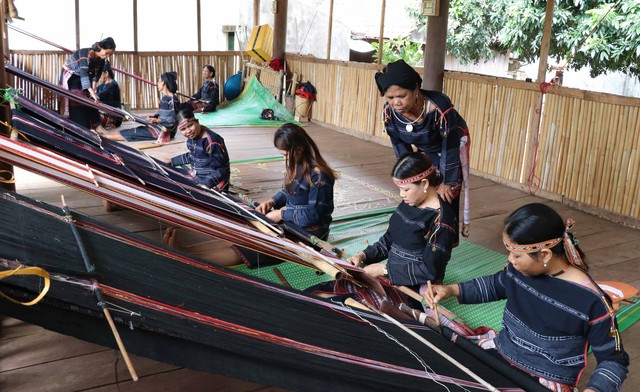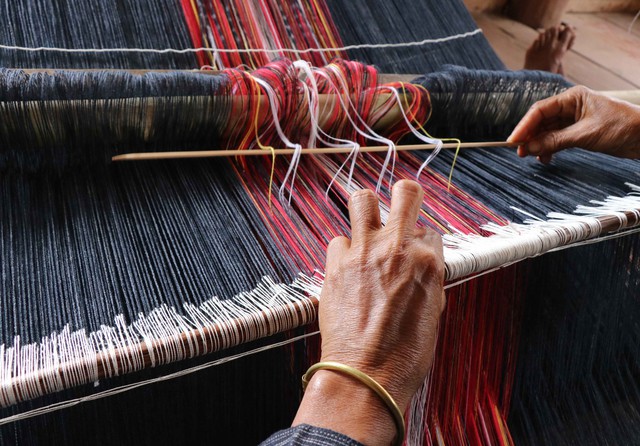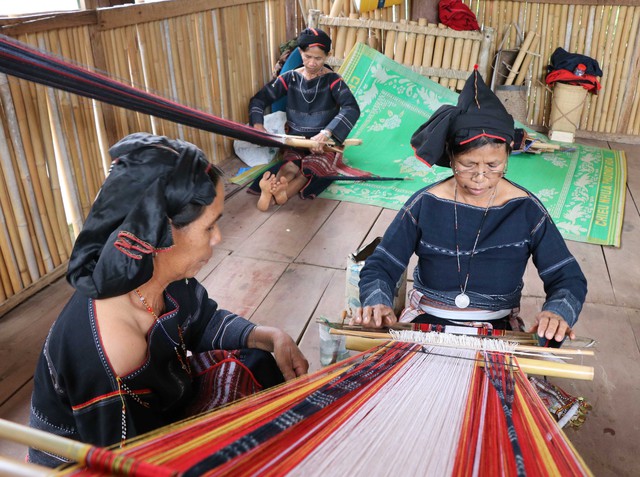Traditional brocade weaving has been a pride of the Bahnar ethnic minority people in the Central Highlands province of Gia Lai for many years. The unique weaving technique and beautiful patterns have been revived under great effort of local people.

Many local women have taken part in a project to preserve and promote Bahnar ethnic minority people's brocade weaving which has been built and carried out for months in Gia Lai Province's Kong Long Khong Commune.
Tran Thi Ngoc Bich, a resident in Kong Long Khong Commune, Kbang District and her partners have built a project to preserve, maintain and and promote the core values of traditional Bahnar brocade nationwide.
The project, which was financed by the British Council, began in late 2021.
Nineteen members have been working hard for months to carry out the project in their commune.
First, they documented the traditional weaving process and then developed it as a curriculum. Then, they organised classes to teach brocade weaving technique to local people. Final, they weaved products with traditional brocade patterns.
"Our target is to produce sample products with Bahnar textile patterns. We redesign the traditional costume of the Bahnar people to be more simple and beautiful, but still keeping its original features," Ngoc said.

Bahnar brocade fabric is used to make beautiful costumes and accessories for both local people and tourists.
Since the beginning of the project, the traditional Rong communal house of Kgiang Village has been a classroom attracting many women to learn their first lessons of weaving under artisans Dinh Thi Hien and Dinh Thi Lam.
"We learn new knowledge and technique, from growing cotton, spinning, dyeing the thread, stretching the frame to weaving," said Dinh Thi Lach.
"We also learn how to develop traditional pattern strips combined with industrial materials to design new products which are ready-to-wear fashion. We are really excited about the new job and work harder for the project," she said.
Meanwhile artisan Hien is happy as she can popularise the weaving craft of the Bahnar people to the wider community.
"I have tried my best to carefully teach them the basic technique so that they can weave fluently before self-improving their skills and creating new patterns to make products more beautiful," said Hien.
She said at her classes, women also learn techniques of applying industrial fibers to brocade weaving to produce trendy costumes which still retain the value of the traditional brocade. It will be unique tourism products, bringing a stable income for villagers in the future.
Bahnar brocade is made from white cotton yarns. All colours were hand-dyed from roots of local plants and trees.

Under instruction of dedicated artisans and hard-working project managers, the unique technique and beautiful patterns of Bahnar people's brocade weaving have been handed down widely in the community.
After weaving, every fabric is like a quintessential masterpiece with a range of typical and beautiful patterns that the artisans called Kiel Ke, Ktonh and Hla hulu.
The masterpiece shows the beauty of the nature and people under the eyes of artisans who love traditional culture, and want to preserve and popularise the unique Bahnar brocade.
Months after the first days, the project has completed and brought remarkable results.
Doctor Vu Huyen Trang, lecturer of the Ha Noi University of Industry's Faculty of Garment Technology & Fashion Design, is a participant of the project and the editor of the curriculum entitled "Bahnar Brocade Weaving".
She said the curriculum, which is considered the first product of the project, includes 23 basic lessons for learners.
Trang and her partners have designed 15 models of skirts and two innovative ao dai (traditional long dress) made of traditional Bahnar brocade fabric and patterns, with prices ranging from only VND300,000-400,000 (US$12.1-16.1) per set.
The new designs use comfortable stretchy materials, which are suitable for daily activities but still retain the traditional shape, delicate patterns, and vivid colours of the brocade.
They go perfectly with accessories such as eye-catching hair bands and bracelets made of brocade fabric.
"I keep the fabric's black background when making costumes for old women meanwhile adding blue, red and yellow to clothing of the young women and girls," said Trang.
"I also add Bahnar brocade patterns to the traditional ao dai of the Kinh people to make a product of cultural exchange between Vietnamese nationalities."

Project manager Tran Thi Ngoc Bich (fourth, right) and artisans have been working hard to make the brocade weaving a livelihood of local residents.
According to Dr Nguyen Thi Kim Van, former director of Gia Lai Province's Museum, the successful implementation of the project has reached two goals.
The traditional weaving of Bahnar people in Kong Long Khong commune has been preserved. The new products which are a combination of traditional brocade and normal fabric are cheaper and can become daily costume for everyone.
"In addition, the brocade costumes which are designed and produced by Bahnar people receive positive feedback from the market. It will be a strong push for artisans," said Van, who is an advisor of the project.
According Ngoc, manager of the project, to make Bahnar brocade a livelihood to bring benefit to local people in long time is not easy. It requires the creativity of the project participants, strong support of the local government, the ministries and the efforts of the Bahnar people themselves.
"In the coming time, a club or a cooperative of brocade weaving will be established so that more products will be made and all people from children to adults, from women to men, can have brocade clothes," said Ngoc.
"This will help spread the brocade weaving to wider people in the community and push the development of the craft to higher level.
"We will focus on developing new products such as hats, hair bands, bags, necklaces, bracelets, etc... for tourism target. It will bring economic benefits and enhance community responsibility in preservation and promotion the cultural values of brocade weaving," she said./.
Thanh Ha